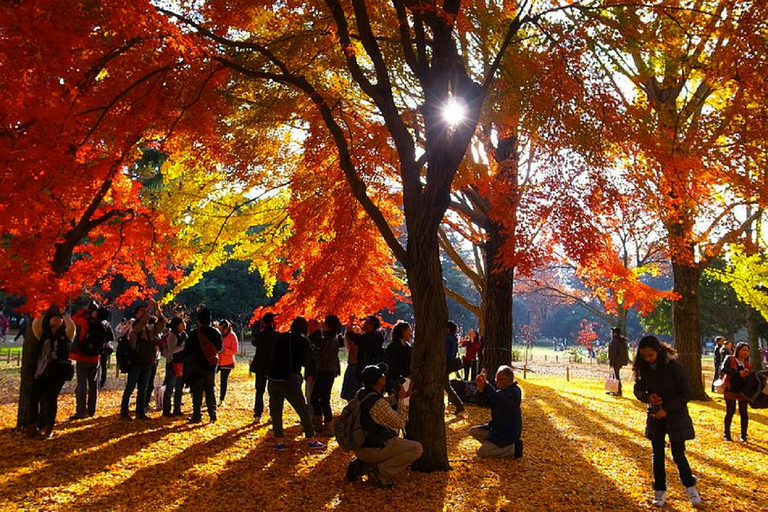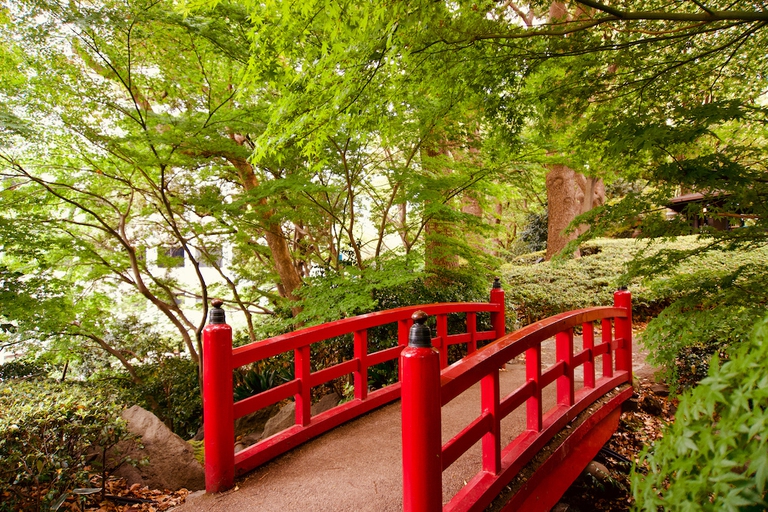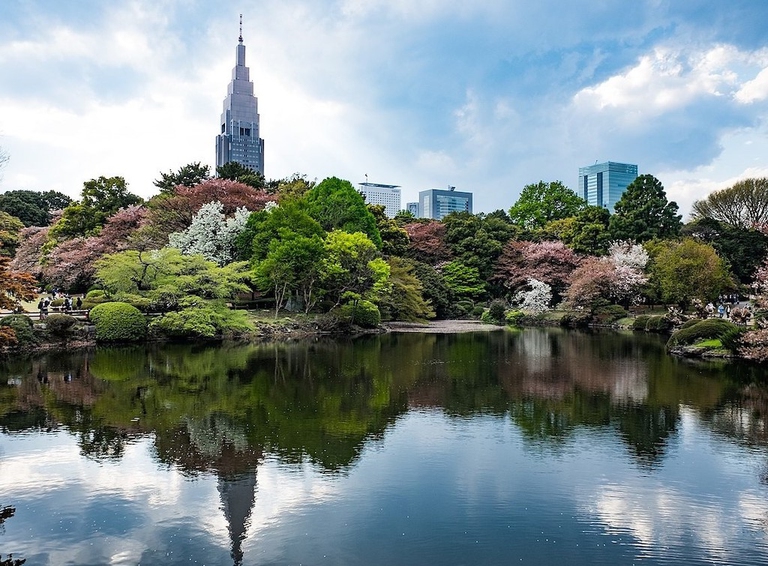
Niseko, Toya-Usu and Shiraoi are three Hokkaido destinations for travellers who want to feel close to the communities they’re visiting.
Not just skyscrapers: the Japanese capital is a much greener city that most people imagine. Let’s discover the best Tokyo parks and gardens from autumn to spring, and anytime in between.
Tokyo is known mainly as a cosmopolitan city of towering skyscrapers and new buildings that change the skyline day after day. Yet, it’s also full of parks and gardens worth exploring, where you can get a little deserved rest from the city frenzy, forgetting that you’re in one of the bustling centres of the modern world for a few hours. Whether you’re looking for a park to spend a day outdoors with friends and family or a quiet garden to find peace, it won’t disappoint you. These are just some of the most beautiful Tokyo parks and gardens you can visit in the Japanese capital to discover an alternative vibe to the metropolis.
If you’re looking for an excellent place for a picnic just a five-minute walk from the famous Meiji Shrine and Omotesando (the most fashionable street in Tokyo), Yoyogi-Kōen is the answer. It’s a favourite for locals, a park where you can take a break surrounded by all sorts of people. It offers a lot of trails, cycling paths, green meadows, ponds and forests of ginkgo trees. During the right time of year, this is one of the best places in the city to witness the famous autumn leaf colours, especially the golden hue of the many ginkgos. Also, within the park there’s a spot where you can rent bicycles (for children too) and enjoy a ride, and you can experience flavours and customs from around the world during the annual fairs and festivals.
Next to Yoyogi-Kōen you can find the above-mentioned Meiji-Jingū: a Shinto shrine dedicated to the Emperor Meiji and Empress Shoken who lived between the 19th and 20th Centuries. The Meiji Shrine temple and adjacent Yoyogi Park make up a large forested area within the densely built-up city. This isn’t a garden or park, but the spacious shrine grounds offer walking paths that are great for a relaxing stroll. Several massive wooden torii gates mark the entrance to Meiji-Jingū and, once crossed, the noises of the city are replaced by a silent forest. The approximately 100,000 trees that make it up were planted during the shrine’s construction, donated from different regions across the country. When you walk through it you can breathe an air of spirituality and tranquility, different from the rest of the city’s feel. If you’re lucky, you may also come across a traditional wedding and experience the Japanese atmosphere even more fully.
The East Garden is part of the Imperial Palace grounds, located right in the centre of the city. It was built out of the original Edo-jō compound: the castle of the Tokugawa Shogunate that ruled from 1603 to 1868. A wide lawn and the remaining foundation of the former castle tower can be found on top of a hill, where the castle’s innermost buildings once stood. At the foot of the hill, instead, you can find a very beautiful Japanese style garden which was created more recently. The Imperial Palace’s East Garden is open to the public and admission is free. Nevertheless, the number of visitors is controlled and limited, so it never feels too crowded. Just keep in mind that it’s closed on Mondays and Fridays.
Hidden inside one of the most famous 5-star hotels in Tokyo, you can discover a beautiful Japanese garden unknown to most. The New Otani Hotel is located near the Imperial Palace and nestled in the heart of this busy centre is a typical Japanese garden with over 400 years of history. These 4-hectare grounds feature several ancient stone lanterns, scarlet bridges over typical ponds, a stone garden, a 6-metre-tall waterfall, as well as a myriad of flowers and rich foliage that bloom and change colours from one season to the next. You can enjoy a real Japanese atmosphere and it isn’t unusual to meet people wearing traditional clothes. It’s permitted to enter and walk around even if you’re not a hotel guest, making this spot one of the best hidden free attractions in Tokyo.
Shinjuku is known as an area full of attractions. It’s the heart of Japanese business and entertainment, home to the homonymous railway station, which is the busiest in the whole world, with over 3.5 million passengers passing through it every day. Just 10 minutes walk away from this huge hub is the Shinjuku-Gyoen National Garden, one of the best spots in Tokyo to admire cherry blossoms, which bloom during the hanami period between the end of March and beginning of April. Inside this big park are three different gardens characterised by very different styles: the French formal garden, the English one and the traditional Japanese type. To recover from the noise of the city, you can take a walk inside this oasis and choose the perfect spot to enjoy hanami (the Japanese word for the cherry blossom viewing) with an amazing skyline on the background. The admission fee is 200 yen (less than 2 dollars) but it’s definitely worth it. If you’re planning to visit Japan this spring, remember that cherry blossoms are predicted to come earlier this year. The Japan Meteorological Corporation announced that the sakura flowers will begin to bloom in Tokyo on 22 March.
Siamo anche su WhatsApp. Segui il canale ufficiale LifeGate per restare aggiornata, aggiornato sulle ultime notizie e sulle nostre attività.
![]()
Quest'opera è distribuita con Licenza Creative Commons Attribuzione - Non commerciale - Non opere derivate 4.0 Internazionale.
Niseko, Toya-Usu and Shiraoi are three Hokkaido destinations for travellers who want to feel close to the communities they’re visiting.
Disabled travellers need not fear Japan. Accessible Japan founder Josh Grisdale tells us about his commitment to opening the country’s doors to everyone.
Antarctica is becoming more accessible, so much so that tourism has seen a 53 per cent increase in the last four years. And climate change is on of the reasons people visit the frozen continent.
Alpinism has officially been added to the UNESCO Intangible Cultural Heritage (ICH) list. Its candidacy had been jointly submitted by France, Italy and Switzerland.
The word biodiversity recalls lush forests inhabited by countless animal and plant species. Life, thanks to its blind determination, blossoms in a myriad of stunning environments: from deserts and volcanoes to mountains covered up by perennial ice. The most extreme and inhospitable ecosystems can host animals and plants that adapted in the name of survival.
Vienna will amaze you with the magnificence of its past and modernity of its services. A tour among the best sights of an environmentally-friendly city with award-winning quality of life standards.
Chile has unveiled the Patagonian Route of Parks, an incredible trail that connects 17 national parks with the aim of promoting nature conservation and community development.
Trekkers throughout the Himalayas have contributed to creating the highest garbage dump in the world. Sustainable tourism in Nepal is still absent, but sorely needed.
Eataly World in Bologna is a culinary city in the country of biodiversity, the largest agri-food centre in the world: an Italian food theme park, if you will. Photos from the opening, so you know what to expect.












